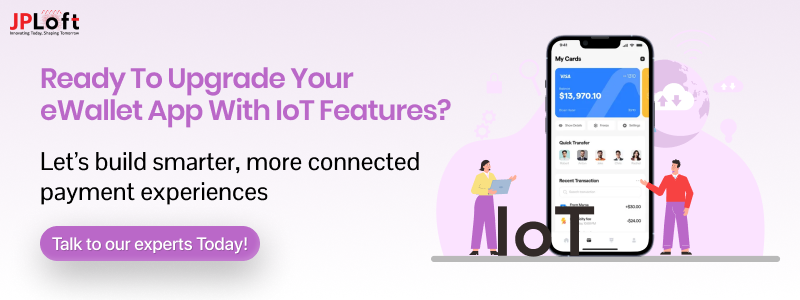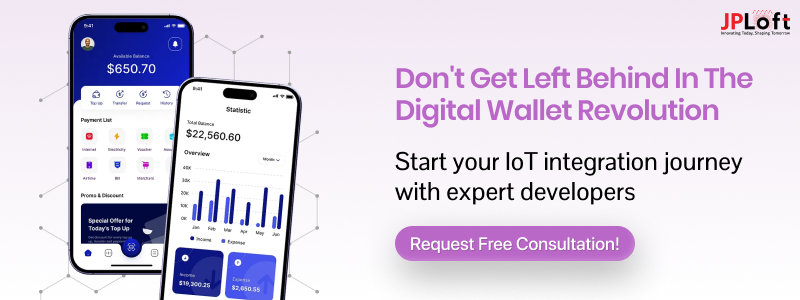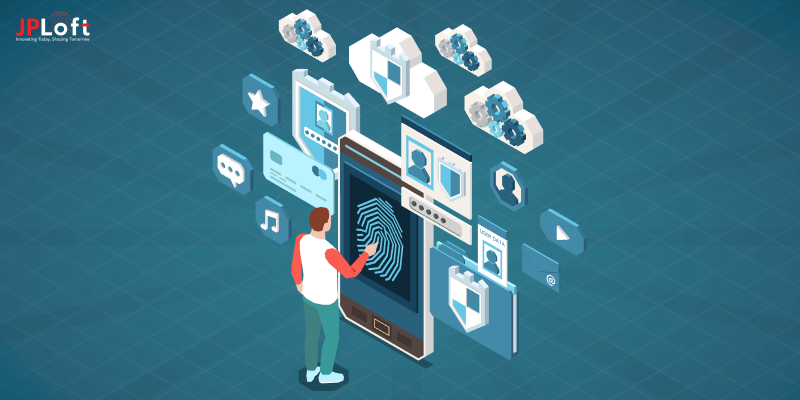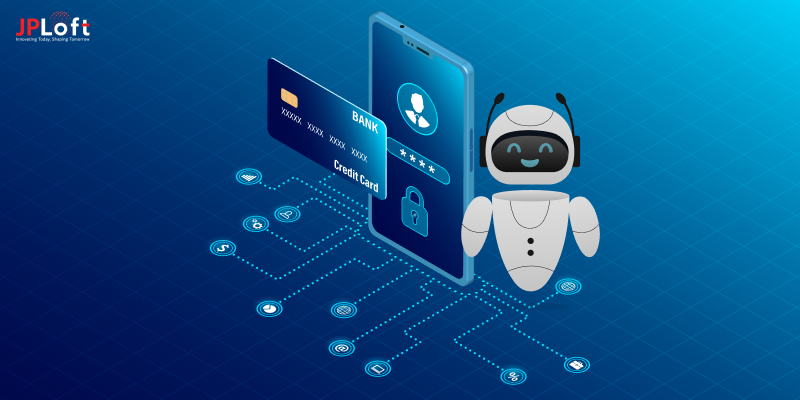Ever imagined paying for coffee through your smartwatch or having your fridge automatically order groceries and pay for them without lifting a finger? Welcome to the world where IoT meets digital wallets.
If you're wondering how to integrate IoT in eWallet, you're tapping into one of the leading trends in fintech.
This blog is your go-to guide to understand how this tech combo is changing the way we pay, interact, and live.
Whether you're a startup looking to develop an eWallet app or a business curious about the next-gen payment revolution, this is where innovation gets real. Let’s break it down in simple, fun terms.
IoT and Digital Wallet: What’s the Link?
The Internet of Things (IoT) is all about smart devices talking to each other over the internet, without human input.
From fitness trackers to voice assistants, IoT is making our daily lives smarter, faster, and way more connected.
Now, imagine linking that intelligence to how you pay for things. Game-changer, right?
What is the Role of IoT in Digital Wallets?
The role of IoT in eWallets is to enhance automation, personalization, and real-time responsiveness.
Whether it's enabling voice-activated payments or allowing your smart car to pay for fuel, integrating IoT in eWallet apps adds a layer of convenience that users now expect.
If you're planning to create an eWallet app, this is a future-proof move.
Here are some stats backing up the growing IoT integration in the eWallet app:
-
- The global number of Internet of Things (IoT) devices is expected to more than double, increasing from 19.8 billion in 2025 to over 40.6 billion by 2034.
- By 2034, China will have the highest number of consumer IoT devices, with approximately 7.51 billion devices in use.
- IoT payments are set to reach $5.4 trillion globally by 2028.
What are the Top Benefits of Integrating IoT in eWallet?
If you want to make your app a top eWallet app, you need to integrate the Internet of Things into eWallet.
It not only enhances the app’s functionality, but also gives users some reason to look forward to your app.
Here are some other benefits of IoT in digital wallets:
1. Enhanced User Convenience
Imagine your wearable paying for your subway ride, or your smart fridge auto-reordering groceries.
That’s the real-world power of the integration of IoT with eWallets.
It makes everyday tasks seamless and reduces the need for repetitive manual actions.
2. Smarter Spending Insights
With data collected from multiple connected devices, IoT-driven eWallets can analyze user behaviour and offer spending insights in real-time.
This isn’t just cool tech, it helps users manage money smarter, based on real lifestyle patterns.
3. Increased Security with Smart Authentication
IoT brings in multi-layered security, like biometrics, location-based verification, and encrypted signals. This drastically reduces fraud risks and enhances trust.
A strong eWallet app feature, when built right with IoT, adds a robust layer of protection.
4. Hyper-Personalized Experiences
From personalized offers based on location to AI-powered spending suggestions, IoT-enabled digital wallets can deliver next-level personalization.
It’s the kind of experience users not only love but expect.
How to Integrate IoT in eWallet?
Knowing the benefits isn’t enough, you might want to take things further to understand how to integrate IoT technology in eWallet.
The integration of IoT in eWallet is a systematic approach that needs proper planning, the right tech stack, security considerations, and user-first thinking.
Below is a step-by-step approach to creating an eWallet app while embedding IoT in it.
1] Define Your IoT Use Case
Before you start coding or picking gadgets, get crystal clear on how IoT will supercharge your eWallet.
Are you enabling tap-to-pay on a smartwatch? Letting a connected car pay for gas automatically? Or maybe letting smart fridges reorder groceries with a single command?
Nail down the use case that excites your audience and aligns with their lifestyle.
Pro Tip: Think beyond the obvious.
Imagine a smart vending machine that deducts funds when you grab a snack or a fitness tracker that rewards you with loyalty points for hitting step goals.
The right use case sets the tone for your IoT with eWallet integration and drives user adoption.
2] Pick the Perfect IoT Devices and Connectivity
Your eWallet needs to fit well with the right hardware.
Whether it’s a sleek smartwatch, a voice-activated speaker, or a car’s dashboard system, choose IoT devices that are user-friendly and widely adopted.
Then, pair them with robust connectivity protocols to ensure snappy, secure communication.
-
- Devices: Think NFC-enabled wearables (Apple Watch, Fitbit), RFID tags for quick scans, or beacons for location-based offers.
- Protocols: Use MQTT for lightweight, real-time messaging, Bluetooth Low Energy (BLE) for close-range connections, or HTTPS for cloud-based interactions.
- Why it matters: A smartwatch that lags during a payment or a car that can’t connect at a toll booth is a buzzkill. Test for low-latency, high-reliability connections to keep the magic alive.
3] Build a Top-Level Backend
When integrating IoT with eWallets, app security is your VIP guest.
You’re dealing with money and sensitive data, so your backend needs to be a fortress. All you need is experts who knows the deal, best is to connect with an experienced IoT development services provider.
Set up a cloud-based infrastructure that can handle real-time transaction processing, device management, and bulletproof security.
Key Components:
-
- Cloud Platform: Use AWS IoT, Azure IoT Hub, or Google Cloud IoT for scalable device management and data processing.
- APIs: Develop RESTful APIs to connect IoT devices to your eWallet backend, enabling seamless payment requests and user authentication.
- Security: Implement end-to-end encryption (TLS/SSL), tokenization for payment data, and OAuth 2.0 for device authentication.
New Trick: Leverage edge computing to process transactions closer to the IoT device, reducing latency and boosting reliability, especially in low-connectivity areas like parking garages or remote tolls.
4] Craft a UI That’s Smooth as Butter
Your eWallet’s interface should feel like a breeze, even with all the IoT wizardry happening behind the scenes.
Focus on a user-centric design that’s intuitive, fast, and tailored to the IoT device’s unique input methods (e.g., voice for smart speakers, taps for wearables).
Design Hacks:
-
- Contextual Prompts: Show “Tap to Pay” on a smartwatch only when near a POS terminal.
- Minimalism: Keep screens uncluttered; nobody wants to scroll through menus on a 2-inch watch face.
- Accessibility: Support voice commands and haptic feedback for inclusivity.
Trend Alert: Embrace emerging trends in eWallet app design like gamified interfaces (e.g., earning badges for frequent payments) or dark mode for power-efficient displays on IoT devices.
5] Power Up with Real-Time Analytics & Notifications
Users love instant gratification, so make sure your eWallet delivers real-time updates that feel like magic.
Whether it’s a “Payment Successful” ping on their smartwatch or a warning about a suspicious transaction, analytics and notifications are the glue that ties IoT with eWallets together.
-
- Analytics: Use IoT data (location, device behaviour) to offer personalized deals, like a coffee discount when a user is near their favourite café.
- Notifications: Push instant alerts to IoT devices or companion apps for transactions, low balances, or security alerts.
- Cool Add-On: Integrate AI-driven fraud detection that analyzes IoT signals (e.g., unusual payment locations) to flag potential threats before they happen.
6] Test Like a Maniac Across IoT Ecosystems
Your eWallet needs to shine on every device, from a tiny smart ring to a car’s infotainment system.
Rigorous app testing ensures your app performs flawlessly across diverse IoT ecosystems and network conditions.
What to Test:
-
- Device Compatibility: Ensure smooth operation on wearables, smart speakers, and even IoT-enabled vending machines.
- Network Scenarios: Test in low-bandwidth areas or spotty Wi-Fi to mimic real-world conditions.
- Latency & Syncing: Confirm transactions process in under a second, and data syncs across devices instantly.
Fun Fact: Simulate a busy coffee shop rush to see if your app can handle 50 simultaneous tap-to-pay requests without breaking a sweat.
7] Launch, Monitor, and Keep It Fresh
You’re ready to launch your IoT-enabled eWallet, but the work doesn’t stop there. Time to move ahead with app maintenance services.
Roll it out in phases, use monitoring tools to keep tabs on performance and user feedback.
-
- Monitoring Tools: Leverage IoT platform dashboards (e.g., AWS IoT Analytics) to track transaction success rates, device uptime, and user engagement.
- Updates: Regularly patch firmware and software to squash bugs and stay ahead of security threats.
- User Feedback: Listen to your users, maybe they want voice payments on their smart speaker to feel more like chatting with a friend.
Bonus: Stay Compliant and User-Obsessed
-
- Compliance: Adhere to PCI-DSS for payment security and GDPR/CCPA for data privacy. Check local IoT regulations to avoid legal hiccups.
- User Love: Add delightful touches like personalized offers based on IoT data (e.g., a discount when a user’s smart car pulls into a partnered gas station) or loyalty points for using IoT features.
Let’s be honest for a moment here, as of right now, Artificial intelligence is revolutionizing IoT-enabled eWallets, the sooner you hop on the trend, the better it is.
How Today’s eWallet Apps Are Getting an IoT Upgrade?
After AI in eWallet apps raised the bar, IoT is now taking innovation to the next level.
Here are some top eWallet apps and how they are integrating the Internet of Things in their eWallet app:
1. Touch 'n Go eWallet ( Malaysia)
Touch 'n Go eWallet is a Malaysian digital wallet that was launched in 2017.
This app has seamlessly integrated IoT into Malaysia’s transportation infrastructure. Users can pay for tolls, street parking, and public transport via RFID or PayDirect.
Taking things further, the app also supports car insurance renewals, mobile top-ups, and even movie ticket purchases, all through IoT-enabled devices.
2. Samsung Pay
Launched in 2015, Samsung Pay leverages IoT by enabling contactless payments through compatible Samsung devices.
Users can make secure transactions using their smartphones or wearables, enhancing convenience and security in everyday purchases.
3. Apple Pay
The app was launched by none other than Apple in the year 2014 and is considered one of the top eWallet apps.
Apple Pay utilises IoT technology to facilitate secure and contactless payments via iPhones, Apple Watches, and other Apple devices.
This integration allows users to make seamless transactions at participating merchants, enhancing the overall payment experience.
4. Google Pay
As you know, Google Pay is considered a top app and was launched in 2017.
Google Pay incorporates IoT by enabling users to make contactless payments using their smartphones or smartwatches.
The app securely stores payment information and utilizes NFC technology to facilitate quick and easy transactions at supported merchants.
5. Amazon Go
This eWallet app was launched in 2016.
Amazon Go revolutionizes the shopping experience by integrating IoT technology,
Shoppers can enter the store, pick up items, and leave without traditional checkout processes.
The app uses sensors and cameras to track purchases automatically, charging the users’ accounts as they exit.
These eWallet apps demonstrate how IoT integration enhances users' convenience, security and overall experience in the digital payment landscape.
By leveraging IoT technologies, these platforms are setting new standards for seamless and efficient transactions.
Challenges in Integrating IoT-Enabled eWallets
Have you considered implementing the Internet of Things technology in a digital wallet? You should also be aware of the challenges one may face.
Here are some of the most common challenges in eWallet app development when integrating with IoT technologies.
A] Device Compatibility & Standarization
IoT ecosystems often involve a wide variety of devices from different manufacturers.
Each may use its own protocols, data formats, and communication methods, making it difficult to create a one-size-fits-all app integration.
B] Security and Privacy
With more connected devices comes more risk.
Ensuring secure communication, data encryption, and safe user authentication is critical but not always easy, especially when dealing with devices that weren’t built with security in mind.
C] Data Management and Scalability
IoT devices generate massive amounts of data.
Managing that data efficiently, storing, analyzing, and syncing it in real-time, requires robust back-end systems that can scale without performance issues.
D] Network Reliability
IoT apps often rely on constant connectivity.
Any disruption in the internet or device-level communication can lead to a poor user experience or even critical system failures.
E] Power Consumption and Performance Optimization
Many IoT devices run on limited battery power.
An app that demands too much processing or constant communication can drain batteries quickly, making energy efficiency a key concern.
F] Firmware and Software Updates
Keeping device firmware and app software updated without breaking functionality is a complex task.
Remote updates need to be secure, reliable, and minimally disruptive.
Future Trends and Innovations in eWallet Apps
As technology keeps evolving, so do the ways we manage money.
The future trends are pointing toward smarter, faster, and more connected experiences, thanks to innovations like IoT, AI, and seamless integrations.
Whether you're a startup or a fintech pro, keeping up with the digital wallet app trends is essential for staying ahead.
Here’s a look at what’s shaping the next generation of eWallet apps:
► Smarter Payments
Imagine your smartwatch automatically paying for your morning coffee as you walk past your favourite café.
That’s where the IoT-powered digital wallet app is headed, enabling context-aware, location-based payments.
As devices get smarter, payments will become more intuitive, seamless, and personalized like never before.
► Hyper-Personalization
With IoT integration in eWallet app experiences, user behaviour can be tracked in real-time to deliver smarter financial suggestions, spending alerts, or location-specific offers.
Want to alert a user when they’re near a store with loyalty points to redeem? That’s the power of hyper-personalization through IoT.
► Voice-Activated Transactions and Smart Assistants
The rise of voice tech means your digital wallet might soon talk back.
Thanks to IoT and AI, voice commands for sending money, checking balances, or finding the best deals are becoming a reality.
As this trend grows, apps that embrace it will lead the app trend in both usability and innovation. An AI app development company can optimize voice payments with NLP and IoT synergy.
► Security Reinvented with Multi-Device Authentication
Security is getting a futuristic upgrade.
Using multiple connected devices like a smartwatch, smartphone, and smart home system,
IoT-powered digital wallet apps can authenticate transactions in real-time using behavioural and environmental data. It’s not just safe; it’s smart security built for the connected era.
Want to bring these features into your own app? It might be time to hire dedicated developers who specialize in future-ready fintech solutions. Let’s build the wallet of tomorrow & today.
How JPLoft Can Help You Integrate IoT in Your eWallet App?
Imagine an eWallet app that not only manages your money but also interacts with your smart devices to make payments, track spending, and even suggest deals based on your location, all in real-time.
That’s the power of integrating IoT into your eWallet app! But making this seamless connection happen? That’s where JPLoft shines.
As a leading eWallet app development company, JPLoft specializes in blending cutting-edge IoT technology with secure, user-friendly payment solutions.
Whether you want smart wearables to trigger payments or connect your car’s dashboard for hassle-free tolls, JPLoft’s expert developers have you covered.
Conclusion
Integrating IoT with your eWallet app isn’t just a tech upgrade; it’s a whole new way to engage users and stay ahead in the competitive fintech market.
JPLoft offers the expertise, creativity, and dedication to bring this vision to life. From flawless device integration to ironclad security and smooth user interfaces, they’re your go-to app development company.
If you want your app to do more than just store money, if you want it to connect, anticipate, and simplify, partnering with JPLoft is the smart move.
FAQs
Smartwatches, cars, smart home devices, fitness trackers, and even connected wearables can all sync with your eWallet app.
They use advanced encryption, multi-factor authentication, and continuous security audits to protect user data and transactions.
Absolutely! IoT enables personalized experiences, real-time offers, and convenient, context-aware payments that keep users hooked.
Timelines vary, but JPLoft provides clear project roadmaps and efficient delivery, often completing integrations within a few months.
JPLoft tailors solutions to budget and scale, making IoT integration affordable and accessible, even for startups and small businesses.













Share this blog